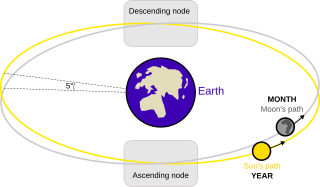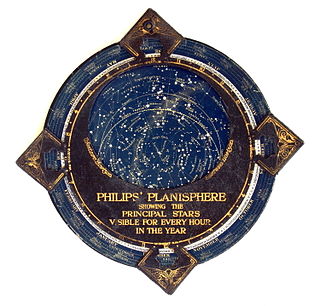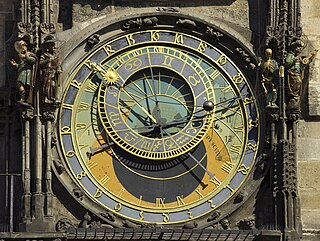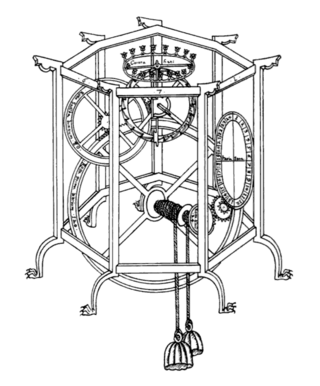
The York Minster astronomical clock is a memorial to the airmen operating from bases in Yorkshire, Durham, and Northumberland who were killed in action during World War II, designed by R. Atkinson, and installed in York Minster in 1955. [1]

The York Minster astronomical clock is a memorial to the airmen operating from bases in Yorkshire, Durham, and Northumberland who were killed in action during World War II, designed by R. Atkinson, and installed in York Minster in 1955. [1]
The clock was first conceived in 1944 and designed by Robert d'Escourt Atkinson, chief assistant at the Royal Greenwich Observatory. Atkinson based the design on the appearance of the sun and stars from the viewpoint of a pilot flying over York. The mechanism and two dials were constructed by A.C.S. Westcott and Royal Greenwich Observatory craftsmen, and installed in the north transept of York Minster in 1955.
Damage to the clock's mechanism was sustained during a fire, on 9 July 1984; after 10 years' work attempting repair, vergers ceased winding it, owing to its inaccuracies of time-keeping.[ citation needed ]

The front dial shows the locations of the Sun and certain navigational stars as would be seen by a pilot flying south above York Minster. To locate his position, a fixed circular plate, about 62 cm (slightly over 2 feet) in diameter and slightly dished, carries a ground plan of the Minster and surrounding markings representative of city walls, rivers, and principal roads. Since the edge of the plate represents the effective horizon, its centre identifies the pilot's nadir.
Mounted behind the plate there is a star-planisphere, based on a north pole stereographic zenithal projection (a projection from the north pole onto a plane passing through the south pole, and perpendicular to the solar axis). This rotates once in a sidereal day on an axis passing through its south celestial pole and located some 13 cm above the centre of the horizon plate. For decoration it carries a few basic star patterns (considerably distorted owing to the projection used) and an eccentric zodiac / ecliptic / calendar ring faced with silver, and restricted in width to the distance between the solstitial points.
Associated with the ring is a rayed apparent-sun emblem whose supporting arm system moves to and fro relative to a main mean-motion arm by an amount corresponding to the equation of time, and also radially to represent changes in the sun's declination. Sun-emblem and horizon-plate therefore combine to show the times of the Sun's rising, southing, and setting throughout the year and, by means of the rays of the sun emblem, the extent of the twilight.
To complete the front dial display, two sets of curved wires are mounted in front of the planisphere. One set of two wires indicates lines of equal altitude 36° and 59.5° and supplements the edge of the horizon plate (altitude 0°); they cross a vertical north–south wire to indicate the Sun's meridian altitude at the equinoxes and solstices respectively. The second set, in addition to the north–south element, forms a complete circle and the sectors of two larger circles; all four wires intersect at the centre of the horizon plate (nadir) and a point near the top of the north–south line (zenith).
The rear planisphere, similar in size to the one in the front but strictly circular, displays the brightest stars of the main circumpolar constellations (Ursa Major, Ursa Minor, and Cassiopeia). It is centred on the north celestial pole and, with its encircling silvered ring of 24 hour intervals, rotates once a sidereal day relative to a fixed meridian-index.
The planisphere is attached to a large wheel driven by a worm gear, which is connected to a gear box containing the wheel-train. The gear wheels have ratios 45⁄29, 71⁄151, and 257⁄187, producing a solar to sidereal ratio of 821115 : 818873 = ( 45 × 71 × 257 ) : (29 × 151 × 187 ) . This produces an approximation for the mean tropical year of 365.24219447 days (compare to 365.24219265 days [2] : for 2000 CE ).
The worm gear serving the similar wheel of the mean-sun arm is connected to the input end of the gear box, and also, through a 3000:1 reduction gear, to a 1500 RPM synchronous electric motor, running off the main electricity supply.
For the equation correction, a wheel on a lever associated with the mean solar arm rolls round an annular cam of sheet brass about 61 cm in diameter. Beneath the planisphere, three small dials show hours, minutes, and seconds of Greenwich Mean Time, and three similar and balancing dials give local sidereal time in degrees, minutes, and seconds of arc. An aperture indicates the name of the day of the week.

Right ascension is the angular distance of a particular point measured eastward along the celestial equator from the Sun at the March equinox to the point in question above the Earth. When paired with declination, these astronomical coordinates specify the location of a point on the celestial sphere in the equatorial coordinate system.
A time standard is a specification for measuring time: either the rate at which time passes or points in time or both. In modern times, several time specifications have been officially recognized as standards, where formerly they were matters of custom and practice. An example of a kind of time standard can be a time scale, specifying a method for measuring divisions of time. A standard for civil time can specify both time intervals and time-of-day.

The equatorial coordinate system is a celestial coordinate system widely used to specify the positions of celestial objects. It may be implemented in spherical or rectangular coordinates, both defined by an origin at the centre of Earth, a fundamental plane consisting of the projection of Earth's equator onto the celestial sphere, a primary direction towards the March equinox, and a right-handed convention.

Sidereal time is a system of timekeeping used especially by astronomers. Using sidereal time and the celestial coordinate system, it is easy to locate the positions of celestial objects in the night sky. Sidereal time is a "time scale that is based on Earth's rate of rotation measured relative to the fixed stars".

A sundial is a horological device that tells the time of day when direct sunlight shines by the apparent position of the Sun in the sky. In the narrowest sense of the word, it consists of a flat plate and a gnomon, which casts a shadow onto the dial. As the Sun appears to move through the sky, the shadow aligns with different hour-lines, which are marked on the dial to indicate the time of day. The style is the time-telling edge of the gnomon, though a single point or nodus may be used. The gnomon casts a broad shadow; the shadow of the style shows the time. The gnomon may be a rod, wire, or elaborately decorated metal casting. The style must be parallel to the axis of the Earth's rotation for the sundial to be accurate throughout the year. The style's angle from horizontal is equal to the sundial's geographical latitude.

An astrolabe is an astronomical instrument dating to ancient times. It serves as a star chart and physical model of visible heavenly bodies. Its various functions also make it an elaborate inclinometer and an analog calculation device capable of working out several kinds of problems in astronomy. In its simplest form it is a metal disc with a pattern of wires, cutouts, and perforations that allows a user to calculate astronomical positions precisely. It is able to measure the altitude above the horizon of a celestial body, day or night; it can be used to identify stars or planets, to determine local latitude given local time, to survey, or to triangulate. It was used in classical antiquity, the Islamic Golden Age, the European Middle Ages and the Age of Discovery for all these purposes.

In astronomy, an analemma is a diagram showing the position of the Sun in the sky as seen from a fixed location on Earth at the same mean solar time, as that position varies over the course of a year. The diagram will resemble a figure eight. Globes of Earth often display an analemma as a two-dimensional figure of equation of time vs. declination of the Sun.

The Antikythera mechanism is an Ancient Greek hand-powered orrery, described as the oldest known example of an analogue computer used to predict astronomical positions and eclipses decades in advance. It could also be used to track the four-year cycle of athletic games similar to an Olympiad, the cycle of the ancient Olympic Games.
Diurnal motion is an astronomical term referring to the apparent motion of celestial objects around Earth, or more precisely around the two celestial poles, over the course of one day. It is caused by Earth's rotation around its axis, so almost every star appears to follow a circular arc path, called the diurnal circle, often depicted in star trail photography.

Solar time is a calculation of the passage of time based on the position of the Sun in the sky. The fundamental unit of solar time is the day, based on the synodic rotation period. Traditionally, there are three types of time reckoning based on astronomical observations: apparent solar time and mean solar time, and sidereal time, which is based on the apparent motions of stars other than the Sun.
In observational astronomy, culmination is the passage of a celestial object across the observer's local meridian. These events were also known as meridian transits, used in timekeeping and navigation, and measured precisely using a transit telescope.

A lunar node is either of the two orbital nodes of the Moon, that is, the two points at which the orbit of the Moon intersects the ecliptic. The ascending node is where the Moon moves into the northern ecliptic hemisphere, while the descending node is where the Moon enters the southern ecliptic hemisphere.

In astronomy, a planisphere is a star chart analog computing instrument in the form of two adjustable disks that rotate on a common pivot. It can be adjusted to display the visible stars for any time and date. It is an instrument to assist in learning how to recognize stars and constellations. The astrolabe, an instrument that has its origins in Hellenistic astronomy, is a predecessor of the modern planisphere. The term planisphere contrasts with armillary sphere, where the celestial sphere is represented by a three-dimensional framework of rings.

The Prague astronomical clock or Prague Orloj is a medieval astronomical clock attached to the Old Town Hall in Prague, the capital of the Czech Republic.

An astronomical clock, horologium, or orloj is a clock with special mechanisms and dials to display astronomical information, such as the relative positions of the Sun, Moon, zodiacal constellations, and sometimes major planets.

The Moon orbits Earth in the prograde direction and completes one revolution relative to the Vernal Equinox and the stars in about 27.32 days and one revolution relative to the Sun in about 29.53 days. Earth and the Moon orbit about their barycentre, which lies about 4,670 km (2,900 mi) from Earth's centre, forming a satellite system called the Earth–Moon system. On average, the distance to the Moon is about 385,000 km (239,000 mi) from Earth's centre, which corresponds to about 60 Earth radii or 1.282 light-seconds.

Rasmus Jonassen Sørnes, was a Norwegian inventor, clockmaker and radio technician, and is most famous for his advanced astronomical clocks, the most precise of which has an inaccuracy of 7 seconds during 1000 years. During his lifetime, Sørnes also designed and built a large variety of agricultural, radio-technical and mechanical devices, only a few of them patented.

A nocturnal is an instrument used to determine the local time based on the position of a star in the night sky relative to the pole star. As a result of the Earth's rotation, any fixed star makes a full revolution around the pole star in 23 hours and 56 minutes and therefore can be used as an hour hand. The 4-minute difference between the solar day and sidereal day requires a correction of this giant clock based on the date of observation, and nocturnal helps to apply this correction.

The Whitehurst & Son sundial was produced in Derby in 1812 by the nephew of John Whitehurst. It is a fine example of a precision sundial telling local apparent time with a scale to convert this to local mean time, and is accurate to the nearest minute. The sundial is now housed in the Derby Museum and Art Gallery.

The Astrarium of Giovanni Dondi dall'Orologio was a complex astronomical clock built between 1348 and 1364 in Padova, Italy, by the doctor and clock-maker Giovanni Dondi dall'Orologio. The Astrarium had seven faces and 107 moving parts; it showed the positions of the sun, the moon and the five planets then known, as well as religious feast days. It was one of the first mechanical clocks to be built in Europe.